Technology Transfer Network - Air Toxics Web Site
Risk Assessment for Toxic Air Pollutants: A Citizen's Guide
Originally published as
EPA 450/3-90-024
March 1991

INTRODUCTION
What are Toxic Air Pollutants?
Toxic air pollutants are poisonous substances in the air that come from natural sources (for example, radon gas coming up from the ground) or from manmade sources (for example, chemical compounds given off by factory smokestacks) and can harm the environment or your health. Inhaling (or breathing) toxic air pollutants can increase your chances of experiencing health problems. For example, inhaling the benzene fumes that are given off when you pump gas into your car can increase your chances of experiencing health effects that have been associated with exposure to benzene, such as leukemia.

What are Health Risks?
Health risks, put simply, are a measure of the chance that you will experience health problems. Exposure to toxic air pollutants can increase your health risks. For example, if you live near a factory that releases cancer-causing chemicals and inhale contaminated air, your risk of getting cancer can increase. Breathing air toxics could also increase your risk of noncancer effects such as emphysema or reproductive disorders.
What is Risk Assessment?
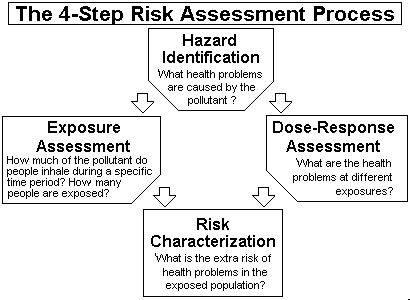 Risk assessment is one tool
used in risk management. It is the process that scientists and government
officials use to estimate the increased risk of health problems in people
who are exposed to different amounts of toxic substances.
Risk assessment is one tool
used in risk management. It is the process that scientists and government
officials use to estimate the increased risk of health problems in people
who are exposed to different amounts of toxic substances.
A risk assessment for a toxic air pollutant combines results of studies on the health effects of various animal and human exposures to the pollutant with results of studies that estimate the level of people's exposures at different distances from the source of the pollutant.
While the estimates provided by these risk assessments are far from perfect, they do help scientists evaluate the risks associated with emissions of toxic air pollutants. Using risk estimates and other factors, the government can set regulatory standards to reduce people's exposures to toxic air pollutants and reduce the risk of experiencing health problems.
HAZARD IDENTIFICATION
or, What Health Problems Are Caused by the Toxic Air Pollutant?
Health Problems of Concern
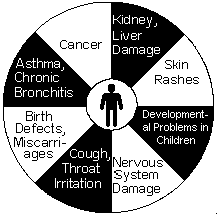 The toxic air pollutants of greatest
concern are those that cause serious health problems or affect many people.
Health problems can include cancer, respiratory irritation, nervous system
problems, and birth defects.
The toxic air pollutants of greatest
concern are those that cause serious health problems or affect many people.
Health problems can include cancer, respiratory irritation, nervous system
problems, and birth defects.
Some health problems occur very soon after a person inhales a toxic air pollutant. These immediate effects may be minor, such as watery eyes. Or they may be serious, such as life-threatening lung damage.
Other health problems may not appear until many months or years after a person's first exposure to the toxic air pollutant. Cancer is one example of a delayed health problem.
Weight of Evidence for Health Problems of Concern
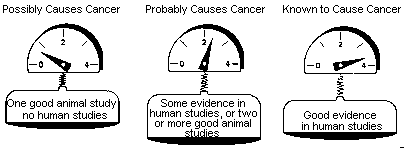 In a hazard identification, scientists
evaluate all available information about the effects of a toxic air pollutant
to estimate the likelihood that a chemical will cause a certain effect
in humans. The better the evidence, the more certain scientists can be
that a toxic air pollutant causes specific health problems. The amount,
type, and quality of evidence are all important.
In a hazard identification, scientists
evaluate all available information about the effects of a toxic air pollutant
to estimate the likelihood that a chemical will cause a certain effect
in humans. The better the evidence, the more certain scientists can be
that a toxic air pollutant causes specific health problems. The amount,
type, and quality of evidence are all important.
The best type of evidence comes from human studies. This evidence may be in the form of case reports, such as physicians' reports of an unusual number of cases of a specific illness. Other more formal studies can be done that compare the number of cases of a particular illness in groups of people with different levels of exposures (for example, cases of leukemia in rubber manufacturing workers).
Because human information is very limited for most toxic air pollutants, scientists often conduct studies on laboratory animals, such as rats. Animal studies are performed under controlled laboratory conditions. Scientists can study a variety of health effects by exposing animals to pollutants at varied concentrations and for varied time periods.
When relying on animal studies only, scientists need to be satisfied that health effects in humans are likely to be the same as those in the animals tested. Scientists try to use animal species with body functions that are similar to humans.
EXPOSURE ASSESSMENT
or, How Much of a Pollutant Do People Inhale During a Specific Time Period?
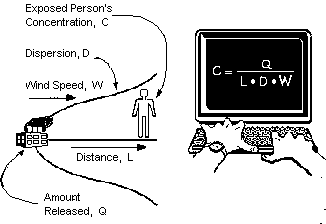 An exposure assessment estimates
how much of a pollutant people inhale during a specific time period, as
well as how many people are exposed.
An exposure assessment estimates
how much of a pollutant people inhale during a specific time period, as
well as how many people are exposed.
There are many sources of toxic air pollutants. For example, a factory smokestack or thousands of automobiles crossing a busy intersection each day could be the source of a pollutant of concern. So the first step in an exposure assessment is to decide which sources are giving off the pollutant of concern.
Once the identity and location of the source(s) are known, the next step is to determine the amounts of the toxic air pollutant released in a specific time period and how it moves away from the source(s).
Engineers use either monitors or computer models to estimate the amount of pollutant released from the source and the amount of pollutant at different distances from the source. Monitors are used to sample the air and measure how much of the pollutant is present.
Computer models use mathematical equations that represent the processes that occur when a facility releases a pollutant and also the movement of pollutants through the air. Factors such as distance from the source to exposed persons, wind speed and direction, and smokestack height (for factories) affect these estimates.
The number of people exposed at different distances from the site of release can be estimated with computer models that use information from the census and from maps. Some models can even estimate exposures for the different places people are each day -- including indoor, automobile, outdoor, and workplace exposures.
The final step in an exposure assessment is to estimate the amounts each person inhales. To do this, scientists combine estimates of breathing rates and lifespan of an average person with estimates of the amount of pollutant in that person's air.
DOSE-RESPONSE ASSESSMENT
or, What Are the Health Problems at Different Exposures?
How Toxic Air Pollutants Move Through the Body
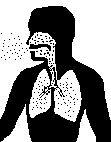
 Entering the Body. [picture
at left] Toxic air pollutants get into the body mainly through breathing.
They can also be ingested (for example, children eating soil contaminated
with lead) or absorbed through the skin.
Entering the Body. [picture
at left] Toxic air pollutants get into the body mainly through breathing.
They can also be ingested (for example, children eating soil contaminated
with lead) or absorbed through the skin.
Movement and Changes in the Body. [picture at right] Once a pollutant enters the body it can stay in the lungs (like asbestos), be exhaled, or move into the blood from the lungs (like the oxygen we breathe) or from the digestive system or skin. In the blood it is carried to all parts of the body. As it moves around the body, a pollutant can undergo chemical changes, especially as it passes through the liver, becoming less, or more, toxic.
Fate. The pollutant can be exhaled, it can leave the body in urine, bowel movements, sweat, or breast milk, or it can be stored in hair, bone, or fat.
How Toxic Air Pollutants Change the Way the Body Works
Toxic air pollutants can cause health problems by interfering with normal body functions. Most commonly they change chemical reactions within individual cells, the building blocks of living things. These changes can kill cells, impair cell function, or re-direct cell activity. The results can be damaged organs, birth defects when the cells of an unborn child are damaged, or cancer that develops when cells begin to grow at an uncontrolled rate.
Dose-Response Relationships
The dose-response relationship for a specific pollutant describes the association between exposure and the observed response (health effect). In other words, it estimates how different levels of exposure to a pollutant change the likelihood and severity of health effects. Just as in the hazard identification, scientists use results of animal and human studies to establish dose-response relationships.
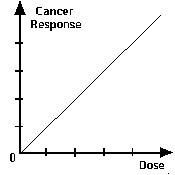
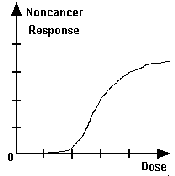 Dose-response relationship for cancer.
[graph to left] In the absence of clear evidence to the contrary, EPA
assumes that there are no exposures that have "zero risk" -- even a very
low exposure to a cancer-causing pollutant can increase the risk of cancer
(albeit a small amount). EPA also assumes that the relationship between
dose and response is a straight line -- for each unit of increase in exposure
(dose), there is an increase in cancer response.
Dose-response relationship for cancer.
[graph to left] In the absence of clear evidence to the contrary, EPA
assumes that there are no exposures that have "zero risk" -- even a very
low exposure to a cancer-causing pollutant can increase the risk of cancer
(albeit a small amount). EPA also assumes that the relationship between
dose and response is a straight line -- for each unit of increase in exposure
(dose), there is an increase in cancer response.
Dose-response relationship for noncancer effects. [graph to right above] A dose may exist below the minimum health effect level for which no adverse effects occur. EPA typically assumes that at low doses the body's natural protective mechanisms repair any damage caused by the pollutant, so there is no ill effect at low doses. However, for some substances noncancer effects may occur at low doses. The dose-response relationship (the response occurring with increasing dose) varies with pollutant, individual sensitivity, and type of health effect.
RISK CHARACTERIZATION
or, What Is the Extra Risk to Health?
Risk information is presented in different ways to illustrate how individuals
or populations may be affected. Some of the most common risk measures are
described here.
Maximum Individual Lifetime Cancer Risks
Combining the results of the exposure assessment and the dose-response assessment gives an estimate of the increased lifetime risk of cancer for an individual exposed to the maximum predicted long-term concentration.

Distribution of Individual Risks
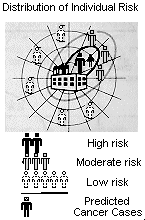 Many people may be exposed
to less than the maximum level. Depending on the amount of exposure, an
individual's risk of cancer will vary. The distribution of individual
risk is usually expressed as the number of people estimated to be at various
levels of risk.
Many people may be exposed
to less than the maximum level. Depending on the amount of exposure, an
individual's risk of cancer will vary. The distribution of individual
risk is usually expressed as the number of people estimated to be at various
levels of risk.
Population Cancer Risks
Distributions of individual risk are used to calculate population risk. The population cancer risk is usually expressed as the expected increased incidence of cancer (that is, the number of new cases each year) for all people exposed to the pollutant. For example, the estimated population cancer risk may be the number of new cancer cases per year expected among residents within 30 miles of a certain large source.
Noncancer Risks
Health reference levels refer to exposure levels that will not cause significant risks of non-cancer health effects. Long-term exposure to levels below these levels are assumed to produce no ill effects.
Health reference levels are an example of one index that government agencies use in characterizing non-cancer health risks. These levels are generally developed from exposure levels that do not produce ill effects in experimental animals. These exposure levels are adjusted to account for animal-human differences (such as breathing rate) and for underlying uncertainties (such as the difference in sensitivity between healthy adults and more sensitive people like children and the elderly).
Risk analysts then compare the health reference levels with the exposure estimates to determine how many people are exposed to concentrations higher than the health reference level. Some of these people might experience ill effects.
Uncertainty in Risk Estimates

Although scientists can estimate risks caused by toxic air pollutants in animals experimentally or in humans who have unusual exposures, converting these estimates to those expected in people under a wide range of conditions is difficult, and can be misleading.
By their nature, risk estimates cannot be completely accurate. The main problem is that scientists don't have enough information on actual exposure and on how toxic air pollutants harm human cells. The exposure assessment often relies on computer models when the amount of pollutant getting from the source(s) to people can't be easily measured. Dose-response relationships often rely on assumptions about the effects of pollutants on cells for converting results of animal experiments at high doses to human exposures at low doses.
When information is missing or uncertain, risk analysts generally make assumptions that tend to prevent them from under estimating the potential risk -- that is, these assumptions provide a margin of safety in the protection of human health.
SUMMING IT ALL UP
- Public health agencies concerned with air quality perform risk assessments
to determine the increased risk of illness from a specific human exposure
to a toxic air pollutant.
- Risk assessment is a four-step process: (1) hazard identification,
(2) exposure assessment, (3) dose-response assessment, and (4) risk
characterization.
- Hazard identification describes the illnesses caused by a toxic air
pollutant and the amount of evidence for those illnesses.
- The size of the increased health risks depends on the exposure level
and duration, as well as the number of people exposed. These are estimated
as part of the exposure assessment.
- The dose-response assessment estimates the dose-response relationship,
which mathematically shows the change in the likelihood of health effects
with changes in the levels of exposure to a toxic air pollutant.
- The risk characterization uses the above assessments to describe the
type and size of any increased risk expected as a result of exposure
to the air pollutant. It also includes a discussion of the uncertainties
associated with the risk estimates.
FOR MORE INFORMATION
- Chemical Exposures: Effects on Health. Fact Sheet CC.
- Write to: Dr. Maria Paviova; U.S. EPA; 26 Federal Plaza, Rm. 737; New York, NY 10278.
- Elements of Toxicology and Risk Assessment.
- Write to: Environ Corporation; 1000 Potomac St., NW; Washington, DC, 20007.
- The Risk Assessment Manual: A Guide to Understanding and Using
Health and Environmental Assessments, by B. Brockband, J.Cohrsson,
and V.T. Covello. Published by the Council on Environmental Quality,
NTIS No. PB89-137772KNK.
- Write to: National Technical Information Service; 5285 Port Royal Rd.; Springfield, VA 22161; $17.50 charge.
- Toxicology for the Citizen, by Alice E. Marczewski and Michael
Kamrin.
- Write to: Center for Environmental Toxicology; Michigan State University; C231 Holden Hall; East Lansing, MI 48824; $1.00 charge.
- Air Pollution. Fact Sheet LL.
- Write to: Dr. Maria Paviova; U.S. EPA; 26 Federal Plaza, Rm. 737; New York, NY 10278.
- The Process of Risk Assessment and Risk Management. FactSheet
BB.
- Write to: Dr. Maria Paviova; U.S. EPA; 26 Federal Plaza, Rm. 737; New York, NY 10278; Free.
- Glossary of Terms Related to Health Exposure and Risk Assessment.
- EPA Air RISC. Call (919)541-0888.
Other Health Risk Publications
Air Pollution and Health Risk.Evaluating Exposures to Toxic Air Pollutants: A Citizen's Guide.
